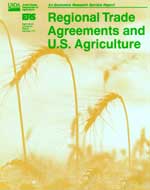Regional Trade Agreements and U.S. Agriculture
- by Mary E. Burfisher and Elizabeth A. Jones
- 11/2/1998
Overview
Regional trade agreements (RTA's) have become a fixture in the global trade arena. Their advocates contend that RTA's can serve as building blocks for multilateral trade liberalization. Their opponents argue that these trade pacts will divert trade from more efficient nonmember producing countries. U.S. agriculture can benefit from participating in RTA's and may lose when it does not. Agriculture is the source of most potential U.S. gains from RTA's. While the United States, as a global trader with diverse trade partners, can gain potentially more from global free trade than from RTA's, many recent RTA's have been more comprehensive in their liberalization of agricultural trade than the Uruguay Round. A strong multilateral process can help ensure that RTA's are trade creating, rather than protectionist. (Please also see Regional Trade Agreements and U.S. Agriculture: An Overview).
Download
-
Entire report
Download PDF -
Frontmatter
Download PDF -
Chapter 1
Download PDF -
Appendix 1. The Economics of Regional Integration
Download PDF -
Appendix 2. Regional Integration and Farm Household Adjustment
Download PDF -
Chapter 2. RTA's and Agricultural Trade: A Retrospective Assessment
Download PDF -
Chapter 3. Multilateral and Regional Trade Reforms: A Global Assessment from a U.S. Perspective
Download PDF -
Chapter 4. A Dynamic Evaluation of the Effects of Western Hemisphere Integration on the U.S. Economy
Download PDF -
Chapter 5. CEEC Accession to the EU: A General Equilibrium Analysis
Download PDF -
Chapter 6. Farm Policy Reforms and Harmonization in the NAFTA
Download PDF -
Appendix 3. Chile Entering NAFTA: Implications for U.S. Horticultural Trade
Download PDF -
Chapter 7. Regional Trade Agreements and Foreign Direct Investment
Download PDF -
Appendix 4. U.S. Foreign Direct Investment in the Global Processed Food Industries
Download PDF -
Chapter 8. Agriculture, GATT, and Regional Trade Agreements
Download PDF -
Appendix 5. U.S.-Israel Free Trade Area Agreement
Download PDF -
Chapter 9. U.S.-Japan Agreements on Beef Imports: A Case of Successful Bilateral Negotiations
Download PDF -
Chapter 10. Economic Integration and Open Regionalism in APEC: The Gains for U.S. Agriculture
Download PDF -
Chapter 11. Enlargement of the European Union to Central and Eastern Europe: Obstacles and Possible Consequences of Policy Harmonization
Download PDF -
Chapter 12. Western Hemisphere Trading Blocs and Tariff Barriers for U.S. Agricultural Exports
Download PDF -
Appendix. Model Documentation
Download PDF

